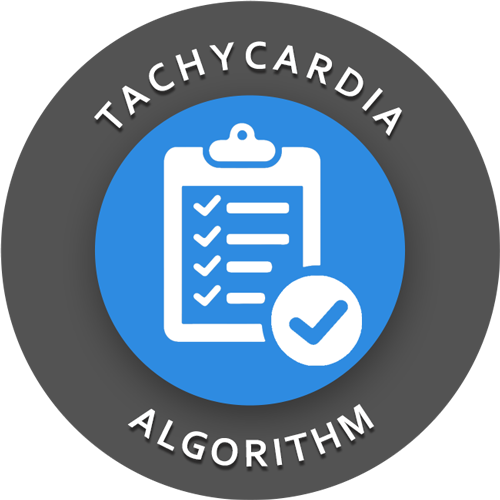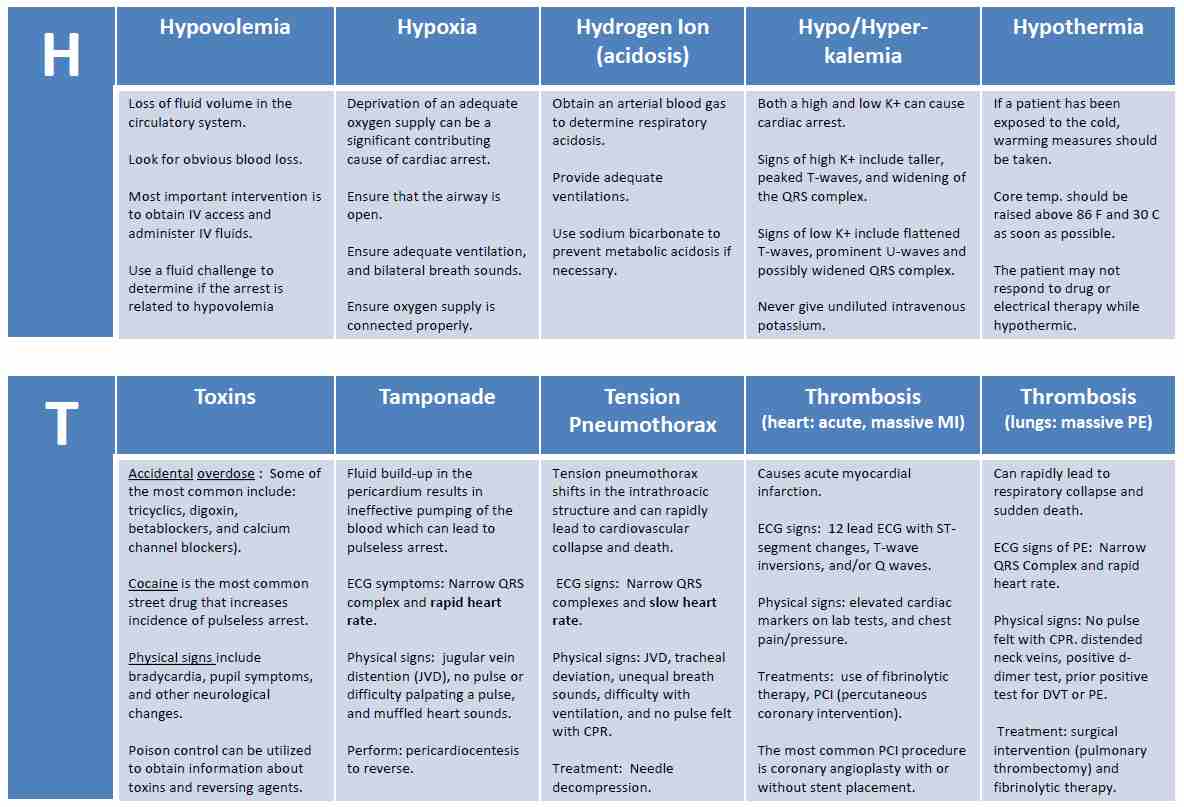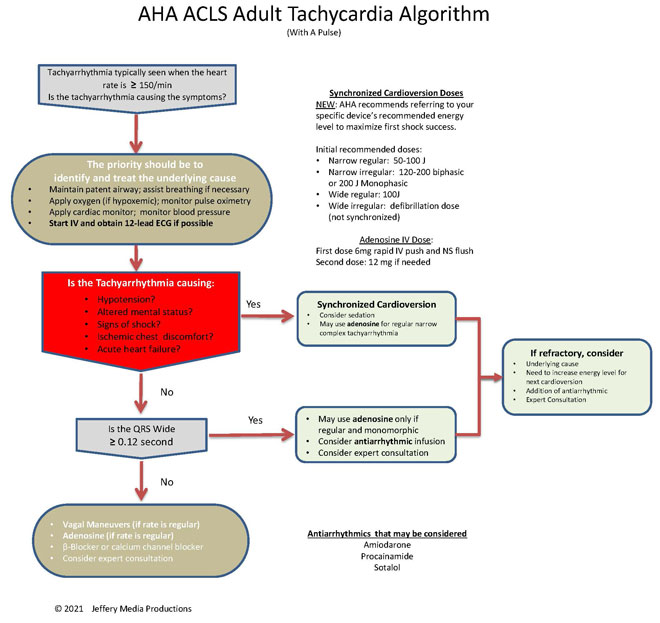 Tachycardia/tachyarrhythmia is defined as a rhythm with a heart rate greater than 100 bpm.
Tachycardia/tachyarrhythmia is defined as a rhythm with a heart rate greater than 100 bpm.
An unstable tachycardia exists when cardiac output is reduced to the point of causing serious signs and symptoms.
Serious signs and symptoms commonly seen with unstable tachycardia are: chest pain, signs of shock, SOA (short of air), altered mental status, weakness, fatigue, and syncope.
One important question you may want to ask is: “Are the symptoms being caused by the tachycardia?” If the symptoms are being caused by the tachycardia treat the tachycardia.
Causes
There are many causes of both stable and unstable tachycardia and appropriate treatment within the ACLS framework requires identification of causative factors. Before initiating invasive interventions, reversible causes should be identified and treated.
The most common causes of tachycardia that should be treated outside of the ACLS tachycardia algorithm are dehydration, hypoxia, fever, and sepsis. There may be other contributing causes and a review of the H’s and T’s of ACLS should take place as needed.
Click below to view the H and T’s table. When done click again to close the diagram.
H’s and T’s Table

Administration of OXYGEN and NORMAL SALINE are of primary importance for the treatment of causative factors of sinus tachycardia and should be considered prior to ACLS intervention.
Once these causative factors have been ruled out or treated, invasive treatment using the ACLS tachycardia algorithm should be implemented.
Associated Rhythms
There are several rhythms that are frequently associated with stable and unstable tachycardia these rhythms include:
- Supraventricular tachycardia (SVT)
- Atrial fibrillation
- Atrial flutter
- Monomorphic VT
- Polymorphic VT
- Wide-complex tachycardia of uncertain type
ACLS Treatment for Tachycardia
Click below to view the tachycardia algorithm diagram. When done click again to close the diagram.
Tachycardia Diagram

or Members Download the Hi-Resolution PDF Here(This will open in another window.)
The first question that should be asked when initiating the ACLS tachycardia algorithm is: “Is the patient stable or unstable?” The answer to this question will determine which path of the tachycardia algorithm is executed.
Unstable Tachycardia
Patients with unstable tachycardia should be treated immediately with synchronized cardioversion. If a pulseless tachycardia is present patients should be treated using the cardiac arrest algorithm.
The AHA no longer provides specific shock dose recommendations for synchronized cardioversion. Instead, they instruct to refer to your specific device’s recommended energy level to maximize first shock success.
For the purposes of a basic understanding of cardioversion, the information about general shock dosages and recommendations will remain in the content on this website.
The initial recommended synchronized cardioversion voltage doses are as follows:
- narrow regular: 50-100 J; i.e., SVT and atrial flutter
- Narrow irregular: 120-200 J biphasic or 200 J monophasic; i.e., atrial fibrillation
- Wide regular: 100 J; i.e., monomorphic VT
- Wide irregular: defibrillation dose (not synchronized)
Stable Tachycardia
Patients with stable tachycardia are treated based upon whether they have a narrow or wide QRS complex. The following flow diagram shows the treatment regimen for stable tachycardia with narrow and wide QRS complex.
- Stable (narrow QRS complex) → vagal maneuvers → adenosine (if regular) → beta-blocker/calcium channel blocker → get an expert
- Stable (wide/regular/monomorphic) → adenosine → consider antiarrhythmic infusion → get an expert
addouglas says
What do the abbreviations MAT (type of irreg. narrow tachycardia) and WPW (as in Afib withWPW) mean?
Jeff with admin. says
MAT means Multifocal atrial tachycardia and WPW means Wolf Parkinson White Syndrome. MAT is A rapid, irregular atrial rhythm arising from multiple ectopic foci within the atria.
WPW is a Pre-excitation Syndrome you can find a brief explanation of this wOLFF-Parkinson-White Syndrome.
Kind regards,
Jeff
Dan Gerard says
I usually suggest amiodarone 150mg over 10 min in stable wide complex prior to adenosine. I know AHA has gone back and forth not adenosine in wide complex but it would seem like if its wide is more often than not VT. Is there any order of preference according to AHA in first choice drug for wide complex stable?
Jeff with admin. says
I have not read that there is a preference of either adenosine or amiodarone being used first for wide complex VT.
Personally, I have, like you, seen amiodarone used for wide complex VT with a pulse more often than adenosine. Amiodarone seems to work well for wide complex VT with a pulse.
Kind regards,
Jeff
rolphnat says
Could you provide some insight on how to tell the difference between SVT and Sinus tach?
Jeff with admin. says
Distinguishing SVT from Sinus Tachycardia (ST) can be difficult. ST rates can reach 200 in some rare cases. It is not uncommon to see a ST rate >150. The primary way to distinguish the two are as follows
Kind regards,
Jeff
Glenn Baumann says
At what point, if ever, does SOB make the tachycardic patient unstable (needing cardioversion) rather than stable (treat with meds and/or cardiology consult)? If patient has SBP>90, no chest discomfort, without obvious signs of shock (skin warm, not pale and diaphoretic)), and mental state seems normal while he’s complaining of feeling very SOB… is he still stable? Should I auscultate his lung fields, and as long as their clear, say that he doesn’t have acute heart failure and stick with stable algorithms?
Jeff with admin. says
If you have tachycardia, SOB will most likely be accompanied by other symptoms. If SOB is the only symptom then you would look at the pulse oximetry and ABG. If this is all WNL, then you would follow the stable tachycardia algorithm and get some expert consultation.
Kind regards,
Jeff
Dave says
Hello ,
What’s the diffrence between stable and unstable SVT
Jeff with admin. says
The patient with stable VT does not have any signs of poor perfusion such as hypotension (SBP < 90), changes in level of consciousness, shock symptoms, syncope, etc. In light of this with unstable VT, the pt. has signs of poor perfusion. The signs listed above indicate poor perfusion. Kind regards, Jeff
jonny says
Please do you have a link to the monophasic and biphasic equivalents when used in cardioversion for treatment of unstable tachycardias?
Jeff with admin. says
It depends on the defibrillator you use, but generically speaking, AHA states that because first shock efficacy for monophasic shocks is lower than first shock efficacy for biphasic shocks, the AHA 2005 Guidelines recommend different initial shock dosages for monophasic defibrillators (360 Joules [J]) and biphasic defibrillators (150-200J). The Guidelines also recommend subsequent biphasic doses at “equal or higher” energy settings.
Therefore any subsequent monophasic dose would be 360 J. 360 J is the max dose for monophasic defibrillation.
Kind regards,
Jeff
Lisa says
Can you please tell me a tachycardic rhythm that has a wide QRS complex? Thanks!
Jeff with admin. says
Here are some examples of a tachycardia that has a wide QRS Complex.
1. Ventricular Tachycardia
2. SVT with aberrant conduction
3. Pacemaker-mediated tachycardia
4. Hyperkalemia induced wide complex tachycardia
5. Torsade de pointes
6. Drug induced wide complex tachycardia (tricyclic antidepressants)
If you are interested, here is a very good article on wide complex tachycardia:
Kind regards,
Jeff
Faymoyo says
Hi Jeff,
What is SOA?
Jeff with admin. says
Short of Air.
Basically the same thing as “short of breath.”
Kind regards,
Jeff
I KLETTER says
How would one best decide to pick lopressor, dig, cardiaz, or amiodorne (150 mg x 10′) for various tacchycardias ?
Jeff with admin. says
This type of decision would hopefully be based on expert consultation from a cardiologist. There are many factors that can affect how a patient responds to these types of medications and experience goes a long way in dealing with stable and unstable tachycardia.
Kind regards,
Jeff
Ramon says
I have a patient with RDH presenting with AF in rapid ventricular response (HR 180), no detectable BP, diaphoretic, non compliance to medication. The patient did not consent for Cardioversion, what is the best antiarrhythmic agent that i could give?
Jeff with admin. says
I’m not sure what RDH stands for. Afib with RVR can be treated in a variety of ways. Here is a link to the AHA recommendations for the treatment of Atrial Fibrillation. (It is a PDF file)
AHA Recommendations for the treatment of atrial fibrillation
It sounds like the patient’s perfusion was significantly compromised. I hope he was ready for some serious chest compressions and an ET tube. I would have chosen the less invasive cardioversion if I were him.
Kind regards,
Jeff
Ramon says
Sorry it was RHD (Rheumatic Heart Disease) not RDH.
But is it warranted to cardiovert if the AF is already permanent? The patient was previously admitted 4 months ago with noted AF already. Thanks
Jeff with admin. says
If the patient has a history of chronic A-fib then they would most likely be being managed by a cardiologist. Unless the patient is unstable and the unstable condition is related to the Atrial fibrillation, it probably would not be advisted to perform cardioversion. If the patient is unstable and cardioversion is necessary, you would need to rule out any thrombus which can occur in the patient with chronic Afib.
Kind regards,
Jeff
Ramon says
Regarding Torsade, why is MgSo4 given slowly when the patient is already arrested and is on CPR? Also, is it true that Amiodarone losses some of its effect if given after MgSO4, or vise versa? Thanks
Jeff with admin. says
When magnesium is given during cardiac arrest for the treatment of Torsades, it should be started as soon as possible, AHA recommendations are over 5-20 minutes but it can be rapid pushed. It can be pushed rapidly over 60 seconds, but may cause hypotension due to a direct vasodilating effect.
I am not aware of amiodarone losing or gaining effectiveness from the administration of MgSO4. Kind regards, Jeff
johnypq1 says
For aha purposes for acls what criteria is used to determine weather patient is considered stable/unstable other than the obvious unresponsive
Jeff with admin. says
There are several criteria:
Hypotension SBP<90
Ischemic chest discomfort
Signs of shock
Acute heart failure
Kind regards,
Jeff
Janay says
Why use adenosine for monomorphic VT? Wouldn’t I be better to use amiodarone or synchronized cardioversion?! I’ve never seen adenosine used for VT ever, nor have I seen a doctor order it… Is this new to ACLS algorithm?
Jeff with admin. says
As of 2010 AHA has stated this position: “Adenosine is recommended as safe and potentially effective for both treatment and diagnosis in the initial management of undifferentiated regular monomorphic wide-complex tachycardia.”
This can be found in the following article under the subheading “Summary of Key Issues and Major Changes.” Highlights of the 2010-2015 AHA ACLS Guidelines.
Kind regards,
Jeff
c17pilotsmom says
this algorithm has always been difficult for me …I’m not sure why …
bfranklin128 says
Jeff,
This is probably a dumb question, but what is SOA? As in “Serious signs and symptoms commonly seen with unstable tachycardia are: chest pain, signs of shock, SOA, altered mental status, weakness, fatigue, and syncope”
Thanks!
Bonnie
bfranklin128 says
Nevermind, Jeff, I figured it out — SOA = Shortness Of Air. I’ve always used SOB = Shortness Of Breath.
Thanks again!
Bonnie
physassist says
SOA-Sons of Anarchy- things get confusing when people start to substitute new words for old nomenclature and abbreviations- screw being PC- it’s SOB-SHORTNESS OF AIR would mean less air in your surrounding environment. Keep using SOB, it’s what we all know!!!!!!!!!!!!!!!!!!!
Jeff with admin. says
Different regions use different abbreviations. SOA means “short of air.” Kind regards, Jeff
jeri capa says
Jeff:
I’ve been teaching ACLS for 25 years, taken & taught the course in multiple states since 1976, I’ve never seen SOA used as an abbreviation, Google search = everything else but your meaning.
Your site is nice, good alternative tutorial, but SOA is misleading and confusing. One might want to alter that portion of the content.
Kind Regards to you too.
J